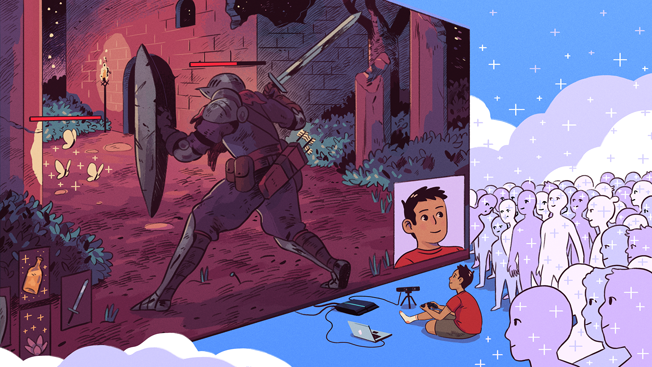Gaming has always been a social pastime, but with Twitch, the live-streaming video game service where viewers watch other people play games as a form of entertainment, it has become a social network. Big tech companies were quick to recognize the value of Twitch—especially it’s huge advertising potential—and last fall Amazon bought the service for $970 million.
The engagement stats are mind-boggling: Twitch hovers around 100 million unique visitors a month, 60 to 70 percent of whom are men ages 18–34, and half of whom live in the United States, according to Quantcast. Collectively, the Twitch community spends more than 16 billion minutes a month watching other users play games. That’s right, 16 billion minutes.
For marketers, Twitch is a new way to reach the elusive millennial male audience, either through mid-roll ads, or, more interestingly, by utilizing its interactive potential. Since the service allows broadcasters to stream from their consoles to desktops, tablets and smartphones, users can watch their favorite players from anywhere. In fact, a third or more of Twitch users view game streams on the go via smartphones and tablets.
Twitch’s community-driven nature led to an interesting platform-specific campaign by Old Spice that mimicked the successful Twitch Plays Pokemon phenomenon. Twitch Plays “Pokemon” was launched in 2014 by an anonymous programmer who uploaded Nintendo’s 1996 Game Boy game, “Pokemon Red,” to Twitch’s servers and started a Twitch channel for the game. The twist was that anyone in the Twitch community could type in commands on the platform’s chat box and control the gameplay. Thousands of players participated in the game while millions more watched.
Naturally, chaos ensued—but the million-plus engaged participants were enough to convince Old Spice and its agency, Wieden+Kennedy, to test out the platform. This April, Old Spice produced its own version of Twitch Plays Pokemon called “Nature Adventure,” in which gamers on Twitch controlled a hired actor, “nature man,” and told him what to do for three days. User requests for nature man included finding a pinecone companion and naming him “Wilson” and burying a slice of pizza in the middle of the forest. In total, the stunt garnered an average of 88,000 unique views per hour, 2.3 million views over the three-day period and more than 32,000 likes on the platform.
Old Spice isn’t the only brand targeting Twitch users: As an extension of its eSports vertical, Red Bull is using the platform to air events centered on competitive video gaming. This past June, Red Bull released specially marked cans of their energy drink at 7-Elevens nationwide that feature imagery from the developer Bungie’s Destiny, an online role-playing action game. Each can had a code that unlocked player advantages and new content in the game. Red Bull then Twitch-streamed the new gameplay area before it was added to the game in September. It made for an effective promotion tactic, as Red Bull tied its product, its eSports channel and its overall mission to position itself as an extreme lifestyle brand together in one push.
Twitch, and other live-streamed video game efforts such as YouTube’s new Gaming channel, are signifiers of a larger streaming trend outside of the gaming world. According to an Adobe Digital Index video report, smartphone video watching has increased by 22 percent since the first quarter of 2014. What’s more, those that stream video to tablet watch just as often as desktop viewers. If more than half of Twitch users watch 20 or more hours a week of streaming video content on the platform—43 percent of whom might be live streaming games or other events from their phones—it’s an indication of the immediate demand for marketers to have content that is in tune with what and where their audiences are watching.
Meanwhile, Twitch is expanding beyond games. It recently launched “Twitch Specials,” which includes concerts and other live events. Even if giants like ESPN will remain dominant for the foreseeable future, young males still tune in to Twitch more frequently than they do to major television networks. That fact, of course, is something no marketer can afford to ignore.









